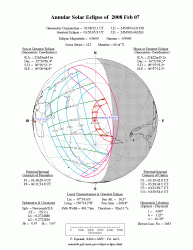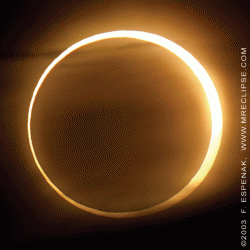While the penguins in Antartica will be putting on their formal wear for the annular solar eclipse, a few lucky SkyWatchers in New Zealand and southeast Australia will still have a chance to see the Moon take a bite out of the solar disc roughly between 01:38:29 and 06:11:55 a.m. GMT. The best place to be is Auckland, New Zealand, where the partial eclipse begins at about 4:48 p.m. (Pacific/Auckland) local time (3:48 a.m. GMT) and ends at about 6:51 p.m. (5:51 a.m. GMT), a little more than two hours later.
The first eclipse of 2008 will travel over Antarctica and the waters surrounding the continent – not a hospitable area for visitors! While there are no permanent human residents in these areas, that won’t stop some travelers from heading towards the barren southern pole to take a look at the annular event. Unlike a total solar eclipse, the New Moon won’t completely cover the solar disc at maximum and a thin ring of the outer fringes of the Sun will still be visible – the annulus. If you were to be in the direct path, you’d enjoy the incredible view of the annular phase from 03:19:43 to 04:30:55 a.m. Greenwich Mean Time (GMT).
Fortunately for those of us who aren’t wearing a permanent tuxedo, the best place to observe will be in Auckland, where the Sun will be covered about 47% at around 5:52 p.m. local time. Considering they’re still enjoying more summer-like weather, it’s time to party! According to Fred Espenak:
 “The most unusual characteristic of this eclipse is that it begins and ends along Earth’s sunset terminator. Most eclipse paths that travel from west to east. However, the 2008 annular eclipse path begins by running east to west and slowly turns north before curving west to east near its terminus. The annular path begins in Antarctica at 03:20 UT when the Moon’s antumbral shadow meets Earth and forms a 581 kilometre wide corridor near the base of the continent’s peninsula region. Traveling westward, the shadow quickly crosses Antarctica and turns north as it heads into the Pacific. Greatest eclipse takes place at 03:55:05 UT when the eclipse magnitude will reach 0.9650. At this instant, the annular duration is 2 minutes 12 seconds, the path width is 444 kilometres and the Sun is 16° above the featureless horizon of the open ocean. The central track continues north before gradually curving to the east where it ends at local sunset at 04:31 UT. During its 1 hour 10 minute flight across our planet, the Moon’s antumbra travels approximately 5,600 kilometres and covers 0.59% of Earth’s surface area.”
“The most unusual characteristic of this eclipse is that it begins and ends along Earth’s sunset terminator. Most eclipse paths that travel from west to east. However, the 2008 annular eclipse path begins by running east to west and slowly turns north before curving west to east near its terminus. The annular path begins in Antarctica at 03:20 UT when the Moon’s antumbral shadow meets Earth and forms a 581 kilometre wide corridor near the base of the continent’s peninsula region. Traveling westward, the shadow quickly crosses Antarctica and turns north as it heads into the Pacific. Greatest eclipse takes place at 03:55:05 UT when the eclipse magnitude will reach 0.9650. At this instant, the annular duration is 2 minutes 12 seconds, the path width is 444 kilometres and the Sun is 16° above the featureless horizon of the open ocean. The central track continues north before gradually curving to the east where it ends at local sunset at 04:31 UT. During its 1 hour 10 minute flight across our planet, the Moon’s antumbra travels approximately 5,600 kilometres and covers 0.59% of Earth’s surface area.”
Remember when viewing a solar eclipse, to always do so safely. If you do not have a proper solar filter, use the projection method with your binoculars or telescopes. Safely cover one side of your binoculars or telescope’s finderscope and aim towards the Sun by aligning the shadow. Project the light onto a surface such as a paper plate or piece of cardboard and adjust the focus until you see a clear circle of light. If you do not have optics, simply punch a pinhole into a dark piece of cardboard and project it onto a makeshift screen. You won’t see solar details like sunspots, but you’ll easily see the progress of the shadow!
Wishing you all clear skies… And share your photos!

